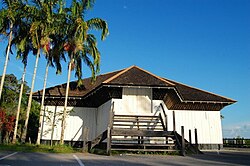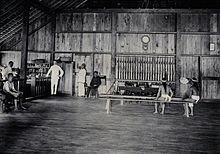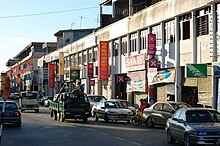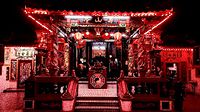Marudi
Marudi
Pekan Marudi | |
|---|---|
Town anddistrict capital | |
 Baram Regional Museum (formerly Fort Hose) | |
| Nickname: Claude Town (Brooke Administration) | |
 | |
| Coordinates:4°11′0″N114°19′0″E/ 4.18333°N 114.31667°E | |
| Country | Malaysia |
| State | Sarawak |
| Division | Miri |
| District | Marudi |
| Government | |
| •District Officer | Belayong Anak Pok |
| Area | |
| • Total | 21,634.0 km2(8,518 sq mi) |
| Population (2010[1]) | |
| • Total | 90,100 |
| Demonym | Marudian |
| Time zone | UTC+8(MST) |
| • Summer (DST) | Not observed |
| Postal code | 9805x |
| International dialling code prefix | 085 (landline only) |
| Vehicle registration plate prefix | QM(for all vehicles except taxis) HQ(for taxis only) |
| Website | www.marudidc.org |
Marudiis a town in theMalaysian stateofSarawak,and is a part of the division ofMiri.It is the seat ofMarudi District,and is located on the banks ofBaram River,about 100 kilometres (62 mi) upstream from the river mouth. Marudi was the administrative centre of the northern region of Sarawak beforeMiriwas established in 1910. Marudi is considered as the cultural heart of theOrang Ulu,the highland tribes of Sarawak. It is also a transit gateway toKelabit HighlandsandGunung Mulu National Park,aUNESCO World Heritage Site.[2]
History[edit]
Up until 1882, the Baram area was ruled by theSultan of Brunei.By that time, the Sultan was having a lot of trouble keeping these vicious tribes in the Baram region under control with their ongoing feuds and bloodletting. Towards the end of the 1800s, the conflicts and the growth of tribal territories had gotten dangerously near to his capital, endangering his personal safety. In this about 10,000 square miles (26,000 km2) domain, the Sultan's power had never previously been used. The Malays never traveled into the interior of Baram out of dread of the Kayan tribe's fury.[3]
Since of this, the Sultan was willing to give up control of the region whenRajah Brookeextended his rule into the higher regions of Baram in exchange for a one-time payment of six thousand dollars annually, which theForeign OfficeinEnglandapproved since they thought it was a reasonable price for the transfer.[3]By 1883, theSultan of Brunei(Abdul Momin) ceded the Baram region (including Miri) to Charles Brooke.[4][5]

The fourth division of Sarawak was immediately created with the installation of Mamerto George Gueritz as the first Resident of the Division. A fort was built in at Marudi, 43 km to the east of Miri.[6]The area was then named Claudetown in honour of Claude Champion de Crespigny, Resident of the Third Division when he died in 1884, and it became the administrative centre of the division. The administration was helped by two junior officers, 30 rangers, and a few native police.[7]
Charles Hosebecame Resident of Baram District in 1891 and the fort in Marudi was renamed Fort Hose. As a result of his concerns about his people' savage practices,Charles Brookeresolved to put a stop to theheadhuntingandblood feudspermanently. He organised a competition amongst all the tribes and startedcockfightingamong them, but the losing tribes didn't take it well, and further fighting broke out. Boat-racing was chosen instead, and Resident Charles Hose designated Marudi as the venue for aregatta.[3]
In 1895 and 1896, the Brooke administration organised an expedition toUsun Apau Plieranto punish theKenyah people(including the Badeng people, a sub-tribe of Kenyahs) living there, who were alleged to have been responsible for the deaths of a Malay, a Chinese trader, and severalIban people.In October 1896, Saba Irang, the headman of the Badeng people, came to Claudetown to seek refuge and make peace with the Brooke administration. Hose decided to organise a peace conference at his fort in April 1899 to “encourage the Madang (Badeng) to be loyal subjects and to ensure a friendly recognition by them by the Baram people".[8]The conference was attended by 6,000 people.[8]This peace conference also led to creation of the Baram Regatta, a long boat race competition among the natives that continues to be held in the present day.[9]
Administration[edit]
The town is the administrative centre ofMarudi District,adistrictin theMiri Divisionof Sarawak, governed by Marudi District Council, which encompasses the districts of Marudi and Mulu, and small portions of the districts are underMiri City Councilsuch asBa'kelalan.[10][11]
Transportation[edit]

Land[edit]
It was officially announced on 13 October 2017, that the 43.2 kilometres (26.8 mi) road project that connects Miri with Marudi is far ahead of its initial 30-month timeline for completion. The road upgrade was supposed to be 12.53% finished by 25 September, however it is already 30.80% finished, or 18.27% ahead of schedule. The road link's poor state and increasing significance prompted the public to express great interest in its improvement, which started on 15 September 2016.[12]The roads that connect Miri and Marudi passes throughplantations,and occasionally have just one lane.[2]The RM75 million Marudi bridge is anticipated to be finished by the end of 2024.[13]
Air[edit]
Marudi is served byMarudi Airport(MUR) which is in the town.De Havilland Canada DHC-6sofMASwingsfly to Miri up to nine times daily and serveBario,Long Banga,Long Lellang,Long AkahandLong Seridan.The airport is a 10-minute (1 km) walk east from the centre. The airport and town center are only a short distance apart, a well-constructedpedestrian walkwayruns beside the major route into town.[2]
Water[edit]
According to SRB statistics, 66,174 passengers passed through the Marudi express boat passenger terminals in total in 2013. However, five years later, in 2018, there were just 3,171 passengers documented, and in 2021, there were none at all. In March 2021, the final express boat service was discontinued. Express boat services were reinstated in 2022 for Marudi and Sungai Tutoh, Baram, to give the locals there more transportation alternatives.[14]
In 2023, thecrocodilepopulation in Marudi enjoys intimidating and terrifying its human neighbors, particularly those who reside in riverfront settlements, given the decreased number of boats that travel the Baram River. Residents depend on these watercraft to get around when they resided in Baram. Back then, the river had once been packed with express vessels,sampans,and various other water vessels, and how it is now much quieter, which may be the reason why more crocodiles have been observed within villages, especiallylonghouses.[15]
Geography[edit]
Climate[edit]
Marudi has atropical rainforest climatewith heavy to very heavy rainfall year-round.
| Climate data for Marudi | |||||||||||||
|---|---|---|---|---|---|---|---|---|---|---|---|---|---|
| Month | Jan | Feb | Mar | Apr | May | Jun | Jul | Aug | Sep | Oct | Nov | Dec | Year |
| Mean daily maximum °C (°F) | 30.1 (86.2) |
30.0 (86.0) |
30.6 (87.1) |
31.2 (88.2) |
31.4 (88.5) |
31.4 (88.5) |
31.1 (88.0) |
31.1 (88.0) |
31.1 (88.0) |
30.8 (87.4) |
30.7 (87.3) |
30.5 (86.9) |
30.8 (87.5) |
| Daily mean °C (°F) | 26.7 (80.1) |
26.7 (80.1) |
27.0 (80.6) |
27.6 (81.7) |
27.7 (81.9) |
27.6 (81.7) |
27.3 (81.1) |
27.3 (81.1) |
27.3 (81.1) |
27.2 (81.0) |
27.1 (80.8) |
26.9 (80.4) |
27.2 (81.0) |
| Mean daily minimum °C (°F) | 23.3 (73.9) |
23.4 (74.1) |
23.5 (74.3) |
24.0 (75.2) |
24.0 (75.2) |
23.8 (74.8) |
23.5 (74.3) |
23.5 (74.3) |
23.6 (74.5) |
23.6 (74.5) |
23.5 (74.3) |
23.4 (74.1) |
23.6 (74.5) |
| Average rainfall mm (inches) | 287 (11.3) |
177 (7.0) |
195 (7.7) |
229 (9.0) |
254 (10.0) |
204 (8.0) |
178 (7.0) |
235 (9.3) |
240 (9.4) |
307 (12.1) |
328 (12.9) |
338 (13.3) |
2,972 (117) |
| Source: Climate-Data.org[16] | |||||||||||||
Infrastructure[edit]

The majority of the structures in Marudi'sgrid-plannedtown center are multi-storyshophouses.This is a typical example ofurban planningin Malaysia prior to the emphasis moving to more dispersedsuburbanprojects.[2]The town has its ownfire station.[17]
Education[edit]
The Chung Hua School was initially founded in 1926, originally within the temple's grounds. In 1926, the primary school welcomed its first students. With only fifteen students, the first headmaster was Goh Jing Chew, and the sessions were initially held in the rear of the tealple. The first wooden building atop a hill was finished in 1936. The wooden structure was destroyed in 1973 due to damage, and a new structure was built in its place. Sim Kheng Hong graced the inauguration ceremony on 4 November 1973.[18]
Places of interest[edit]
Fort Hose, a wooden fort built during theBrooke administration,[19]is situated near the town center and directly off the road that leads from the airstrip to the town center. The fort's construction was finished in 1891, and it stood until a fire destroyed it in 1994. The building that is seen now is a renovated model that debuted in 1997. Charles Hose is honoured by the fort's name. Today, the Baram District Museum is located within the fort. The location overlooks theBaram River.[2]
Marudi Tua Pek Kong is situated within Marudi's commercial center. The temple has weathered three big fire catastrophes in the town's history without any damage.[20]Back then, Chinese businessmen arrived in Southeast Asia to do business, they erected a temple dedicated toTua Pek Kong.This would be their regular meeting spot going forward.[21]The Baram River is just next to the temple. The lone Chinese temple in Marudi was constructed in 1891. Though relatively tiny in comparison to other Chinese temples in the area, the temple remains an essential component of the town.[2]
The Marudi Market is one among the sites along Jalan Kampung Cina. In the morning, the market is generally bustling with activity.[2]The ground floor is home to the neighborhood market. On the first level, there is a food court as well. The majority of the shops provide a variety of rice and noodle meals, coffee, and tea.[22]
According to Datu Dr. Penguang Manggil, the Marudi Waterfront expansion project and the first stage of a planned three-star hotel should be finished by 2025. The Sarawak Economic Development Corporation (SEDC) will construct an RM35 million, 90-room hotel on the site of the former Marudi Rest House. The present waterfront, which was overflowing at the most recent Baram Regatta 2023, will be gradually extended to 1.5 km, making it one of the longest in the state. Theesplanadeexpansion and slope protection would cost around RM35 million each, according to the Department of Irrigation and Drainage.[13]
Baram Ragatta[edit]
When Charles Brooke selected Marudi as the administrative hub for Sarawak's northern district after racial unrest in Baram, the town was then known as Claude Town. The locals enthusiastically embraced the offer made by the then-resident, Charles Hose, to hold a boat race between all the rival races in order to put an end to the carnage. In 1899, the Baram Regatta was initiated as a means of promoting peace among the many tribes. The event drew in over 6,000 participants from Baram, including Ibans, Kenyahs, Kayans, Narums,Melanaus,Malays, and Madangs. Since that point, the regatta has grown to be a yearly occasion that attracts visitors of all ethnicities from Baram and other places.[23][9]
Gallery[edit]
-
Baram Regatta Statue
-
Marudi Tua Pek Kong
-
Marudi Lecture Hall
-
Marudi Wharf Terminal
-
Marudi Airport
References[edit]
- ^"Basic Population Characteristics by Administrative Districts, published by the Department of Statistics, Malaysia"(PDF).Archived fromthe original(PDF)on 21 May 2012.Retrieved26 July2011.
- ^abcdefg"Town on the Baram: Spending 6 hours in Marudi, Sarawak - Urbanist Wanderer".23 December 2022.Retrieved8 January2024.
- ^abc"Sarawakiana@2: What is Marudi Famous For? (2)".Sarawakiana@2.20 July 2011.Retrieved8 January2024.
- ^"Chronology of Sarawak throughout the Brooke Era to Malaysia Day".The Borneo Post. 16 September 2011. Archived fromthe originalon 6 February 2015.Retrieved24 March2015.
- ^"Laman Web Rasmi Pejabat Residen dan Daerah di Miri - Sejarah Miri (Official Website of Miri Resident and District Office - History of Miri)"(in Malay). Miri Resident and District Office. Archived fromthe originalon 2 April 2015.Retrieved24 March2015.
- ^Joseph, Anthony (28 May 2012)."Road upgrade will reduce Miri—Marudi traveling time".The Borneo Post. Archived fromthe originalon 26 March 2015.Retrieved26 March2015.
- ^Hose, Charles; McDougall, William (1912).The pagan tribes of Borneo; a description of their physical, moral and intellectual condition, with some discussion of their ethnic relations, vol.2.Macmillan and Co. Ltd. p. 279. Archived fromthe originalon 2 April 2015.Retrieved24 March2015.Alt URL
- ^abMashman, Valerie (2021)."A Shield for the Rajah – a Gift from the Kenyah Badeng of Borneo in Rome".Journal of Borneo-Kalimantan.7(1).Retrieved18 July2021.
- ^abMadian, Amrizan (2011)."Baram Regatta A Testament Of Racial Harmony".Bernama. Archived fromthe originalon 24 March 2015.Retrieved24 March2015.
- ^"TALIKHIDMAT".talikhidmat.sarawak.gov.my.Retrieved8 January2024.
- ^"Laman Web Rasmi Majlis Daerah Marudi".marudidc.sarawak.gov.my.Retrieved8 January2024.
- ^CMSadmin (13 October 2017)."Cahya Mata Sarawak | Miri-Marudi Road upgrading works well ahead of schedule".Retrieved8 January2024.
- ^ab"Penguang: 2025 completion date expected for Marudi waterfront extension, proposed first phase of 3-star hotel".Borneo Post Online.6 October 2023.Retrieved8 January2024.
- ^"Transport Minister: Express boat services in Marudi, Sungai Tutoh to resume by August 2022".Borneo Post Online.10 June 2022.Retrieved8 January2024.
- ^"Baram River: Express boats go down, crocodiles come up (Travelogue Day 4)".DayakDaily.25 March 2023.Retrieved8 January2024.
- ^"Climate: Marudi".Climate-Data.org.Retrieved29 October2020.
- ^"Flooding in Marudi subsides, workers cleaning up mud at market area".Borneo Post Online.23 November 2022.Retrieved8 January2024.
- ^"Sarawakiana@2: Baram Tales: Founders of Chung Hua School of Marudi".Sarawakiana@2.16 May 2022.Retrieved8 January2024.
- ^"Fort Hose, Marudi, Sarawak".Sarawak Tourism Board.Sarawak Tourism Board.Retrieved4 February2015.
- ^"Tua Pek Kong, Marudi".Tua Pek Kong, Marudi.Retrieved8 January2024.
- ^"Sarawakiana@2: Baram Tales: Founders of Chung Hua School of Marudi".Sarawakiana@2.16 May 2022.Retrieved8 January2024.
- ^"Exloring Marudi Town".Dayak Wanderer.20 February 2020.Retrieved8 January2024.
- ^"Marudi town now and then, according to Penguang".Borneo Post Online.21 March 2019.Retrieved8 January2024.







